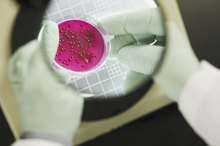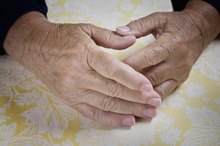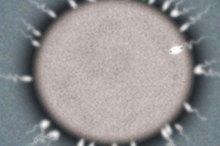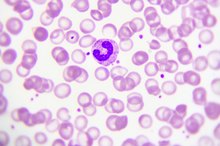Differences Between Antibody & Antibiotic
An infection involves the colonization of tissues in the body by bacteria, viruses or fungi. During the infection process, the infectious agent enters the body, identifies cells containing specific factors that facilitate infection, and then colonizes cells or tissues, leading to disease. Both antibodies and antibiotics play a role in fighting off infections, but they differ in a number of ways.
Chemical Structure
Antibodies and antibiotics typically have very different chemical structures. Each antibody molecule contains two large proteins called heavy chains that bind to two smaller proteins called light chains, all of which bond together to form a Y-shaped structure, according to the University of Arizona 1. The ends of the light and heavy chains form the variable region, which allows each antibody to bind to one specific molecule, or antigen, to help fight off a specific type of infection. Although the variable region differs from antibody to antibody, the general structure of each antibody molecule remains consistent 1. In contrast, antibiotics may contain a wide range of structures, including series of chemical rings, and do not exhibit the same structural consistency as antibodies.
Origin
Differences Between Strep A & Strep B
Learn More
Another major difference between antibodies and antibiotics is in their respective origins. Antibodies are naturally produced in the body by immune system cells. In response to an invading pathogen, the stimulation of the immune system triggers the synthesis of antibodies that can be used to fight off its infection. All naturally occurring antibodies are generated within the body in specialized blood cells called B cells.
Antibiotics, on the other hand, can come from a range of sources. These chemicals may be purified from plants or microorganisms that naturally produce these chemicals to fight off infection.
- Another major difference between antibodies and antibiotics is in their respective origins.
- All naturally occurring antibodies are generated within the body in specialized blood cells called B cells.
Mechanism of Action
Antibodies and antibiotics also differ in their mechanism of action: the way they kill pathogens and fight off infection. Antibodies produced in B cells bind to specific factors, called antigens, found on the pathogen. Once an antibody binds an antigen, the antibody triggers an activation of the immune system. The antibody signals for immune system cells to engulf and digest the infectious invader, helping to neutralize the infection.
Antibiotics, on the other hand, typically work by inhibiting essential cellular functions the infectious bacteria requires to live and divide. Penicillin, the first discovered antibiotic, works by preventing synthesis of the cell wall, an essential step in bacterial cell division, according to Elmhurst College 2. Without proper cell wall formation, water can rush into the bacteria and cause the cell to burst, thereby treating the infection.
- Antibodies and antibiotics also differ in their mechanism of action: the way they kill pathogens and fight off infection.
- Antibodies produced in B cells bind to specific factors, called antigens, found on the pathogen.
Related Articles
References
- University of Arizona: Antibody Structure
- Elmhurst College: Antibiotic—Penicillin
- Janeway C. Immunobiology. Garland Publishing. Print.
- Schroeder HW, Cavacini L. Structure and function of immunoglobulins. J Allergy Clin Immunol. 2010;125(2 Suppl 2):S41-52. doi:10.1016/j.jaci.2009.09.046
- Vidarsson G, Dekkers G, Rispens T. IgG subclasses and allotypes: from structure to effector functions. Frontiers Immunol. 2015:5: 520. doi:10.3389/fimmu.2014.00520
- Thomas H. Unlocking the secrets of IgA. Nat Rev Gastroenterol Hepatol. 2018;15(7):389. doi:10.1038/s41575-018-0036-3
- Heyman B, Shulman, MJ. Structure, function, and production of immunoglobulin M (IgM). Encyclopedia Immunobiol. 2016;2016;1-14. doi:10.1016/B978-0-12-374279-7.05001-3
- Capolunghi F, Rosado MM, Sinibaldi M, Aranburu A, Carsetti R. Why do we need IgM memory B cells?. Immunol Letters. 2013;152(2):114-20. doi:10.1016/j.imlet.2013.04.007
- Sutton BJ, Davies AM, Bax HJ, Karagiannis SN. IgE antibodies: From structure to function and clinical translation. Antibodies (Basel). 2019;8(1):19. doi:10.3390/antib8010019
- Fitzsimmons CM, Falcone FH, Dunne DW. Helminth allergens, parasite-specific IgE, and its protective role in human immunity. Front Immunol. 2014;5:61. doi:10.3389/fimmu.2014.00061
- Edholm ES, Bengten E, Wilson M. Insights into the function of IgD. Dev Comp Immunol. 2011;35(12):1309-16. doi:10.1016/j.dci.2011.03.002
- Liermann K, Schäfler A, Henke A, Sauerbrei A. Evaluation of commercial herpes simplex virus IgG and IgM enzyme immunoassays. J Virol Methods. 2014 Apr;199:29-34. doi:10.1016/j.jviromet.2014.01.001
Writer Bio
Sylvie Tremblay holds a Master of Science in molecular and cellular biology and has years of experience as a cancer researcher and neuroscientist. Based in Ontario, Canada, Tremblay is an experienced journalist and blogger specializing in nutrition, fitness, lifestyle, health and biotechnology, as well as real estate, agriculture and clean tech.









